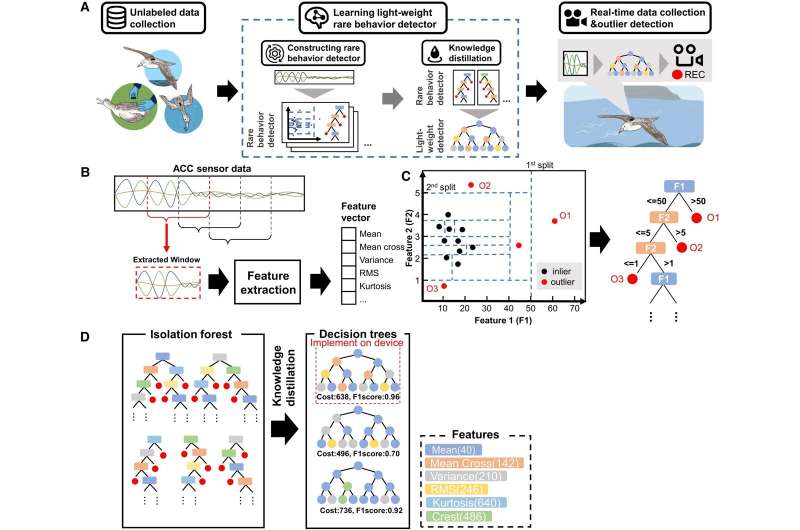This article has been reviewed according to Science X's editorial process and policies. Editors have highlighted the following attributes while ensuring the content's credibility:
fact-checked
peer-reviewed publication
trusted source
proofread
Tiny AI-based bio-loggers revealing the interesting bits of a bird's day

Have you ever wondered what wildlife animals do all day? Documentaries offer a glimpse into their lives, but animals under the watchful eye do not do anything interesting. The true essence of their behaviors remains elusive. Now, researchers from Japan have developed a camera that allows us to capture these behaviors.
In a study recently published in PNAS Nexus, researchers from Osaka University have created a small sensor-based data logger (called a bio-logger) that automatically detects and records video of infrequent behaviors in wild seabirds without supervision by researchers.
Infrequent behaviors, such as diving into the water for food, can lead to new insights or even new directions in research. But observing enough of these behaviors to infer any results is difficult, especially when these behaviors take place in an environment that is not hospitable to humans, such as the open ocean. As a result, the detailed behaviors of these animals remain largely unknown.
"Video cameras attached to the animal are an excellent way to observe behavior," says Kei Tanigaki, lead author of the study. However, video cameras are very power hungry, and this leads to a trade-off. "Either the video only records until the battery runs out, in which case you might miss the rare behavior, or you use a larger, heavier battery, which is not suitable for the animal."
To avoid having to make this choice for the wild seabirds under study, the team use low-power sensors, such as accelerometers, to determine when an unusual behavior is taking place. The camera is then turned on, the behavior is recorded, and the camera powers off until the next time. This bio-logger is the first to use artificial intelligence to do this task.
"We use a method called an isolation forest," says Takuya Maekawa, senior author. "This method detects outlier events well, but like many other artificial intelligence algorithms, it is computationally complex. This means, like the video cameras, it is power hungry." For the bio-loggers, the researchers needed a light-weight algorithm, so they trained the original isolation forest on their data and then used it as a "teacher" to train a smaller "student" outlier detector installed on the bio-logger.
The final bio-logger is 23 g, which is less than 5% of the body weight of the Streaked Shearwater birds under study. Eighteen bio-loggers were deployed, a total of 205 hours of low-power sensor data were collected, and 76 5-min videos were collected. The researchers were able to collect enough data to reveal novel aspects of head-shaking and foraging behaviors of the birds.
This approach, which overcomes the battery-life limitation of most bio-loggers, will help us understand the behaviors of wildlife that venture into human-inhabited areas. It will also enable animals in extreme environments inaccessible to humans to be observed. This means that many other rare behaviors—from sweet-potato washing by Japanese monkeys to penguins feeding on jellyfish—can now be studied in the future.
More information: Kei Tanigaki et al, Automatic recording of rare behaviors of wild animals using video bio-loggers with on-board light-weight outlier detector, PNAS Nexus (2024). DOI: 10.1093/pnasnexus/pgad447
















